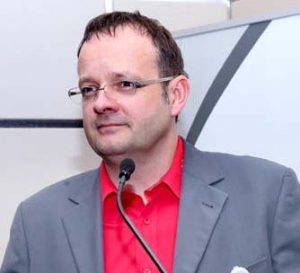
A Gulf-based satellite operator, a satellite service provider from Germany and an antenna manufacturer from China, are poised to offer satellite at the price of fibre across Africa.
The competition has still not woken up says Markus Haut, General Manager of Germany-based satellite service provider, Level421. He is poised to offer satellite capacity at the price of fibre across countries such as the Congo, Somalia, Sudan, Mauritania, Angola and Cote d’Ivoire, among other countries.
“But it is inevitable that in a couple of years, the competition will catch up and I hope people acknowledge our role as pioneers,” he adds with a laugh.
On the face of it, it seems simple enough to do what Haut and his team at Level421 are doing. The Arabsat satellite 5C with its six transponders of 72 MHz each, offer a payload of extended C-band. However, the ground work established by Level421 over a 12-year period is not easy to replicate. Building a network of resellers on the ground in the countries mentioned above is just one of the many time-consuming exercises. And secondly, there is the important task of putting together a cost-effective package for this particular project. Level421 approached its old acquaintance, China-based antenna manufacturer, Probecom.
“We have deployed prototypes in the field for more than a year now. They were installed under special permission from Arabsat. It is very hard to reach a value of 30Gb isolation in extended C-band, but with some adjustments and replacing the feed on the antenna several times, we are now at a point where these antennas fulfill our requirements”
“We’ve known the company for many years over several antenna projects. Probecom was granted type approval in extended C-band by Arabsat a few months ago. Coupled with that, the antennas were to be manufactured at an acceptable price point that was critical to offer cost-effective services,” explains Haut.
Rigorous process of type approval
Indicating the rigorous process of type approval, Mueid. Al-Zahrani, CTO, Arabsat, speaking to SatellitPro ME, recalls, “We followed the universal type approval standards drawn up by the Global VSAT forum. Our engineers visited the Probecom factory in China and witnessed all the testing procedures. Moreover, Probecom took the initiative and sent an antenna to our site so we could test it for compliance. The response we received from Probecom throughout the process was very encouraging.”
Al-Zahrani explains the reason why Arabsat is offering extended C-band. “In the orbital longitude 20 deg East, we offer coverage over Africa and we have already utilised the standard C-band spectrum, so C-extended band will enable us expand and offer additional capacities.
“The issue is not that difficult. To ensure quality of service, we offer, like others, circular polarisation. The bigger manufacturers have to just customise the feed of the antenna. But the bigger manufacturers need to have a sizeable order in place before they take the initiative to produce the equipment.”
The annual Arabsat Telecom forum held in Dubai in late 2012, was the first time the joint endeavour on the parts of Level421, Arabsat and Probecom was presented on a public platform.
Haut speaks briefly about the rigorous testing that was undertaken on the field by the Level421 team.
“We have deployed prototypes in the field for more than a year now. They were installed under special permission from Arabsat. It is very hard to reach a value of 30GB isolation in extended C-band, but with some adjustments and replacing the feed on the antenna several times, we are now at a point where these antennas fulfill our requirements.”
“The ideal computer for Africa is the 3G-enabled Android tablets – this will create a huge demand for internet connectivity accross the continent. We see our future customers in this sector”
The obvious concern with extended C-band is the real possibility of interference with WiMAX operations. Insiders will also tell you that any platform transmitting radio frequency “is pretty much out of control” in Africa. While responding to how this thorny issue was dealt with, Haut gives us an inkling into his in-depth knowledge of the continent and the capabilities of his resellers.
“Regulatory measures in many of the countries are quite weak – that is the reality. But we know the regions that will pose real problems. There are certain mega-cities where the usage of C-band, regular or extended, is a real problem. In certain places, there is so much interference that no technology is working properly.
“But we are not talking about these cities that are pretty well known to all operators. We are talking about other regions and of course there are challenges with offering extended C-band. We have developed RF filters for the satellite antennas. If we have an environment where WiMAX is present, we can specifically block those frequencies.
“In the orbital longitude 20 deg East, we offer coverage over Africa and we have already utilised all the standard C-band spectrum, so extended C-band will enable us expand and offer additional capacities” – Mueid. Al-Zahrani, CTO, Arabsat
“In addition, we employ a full transponder. Interference is more likely if the carrier is smaller, so if you uplink to a full transponder of 72 MHz – even if there is interference – there is more resistance against this interference.”
The limited reach of fibre
With the price for raw satellite capacity for extended C-band that is at a reported 30% cheaper than regular C-band, the price factor would be a compelling draw for mobile service providers wanting satellite backhaul. Moreover, the state of fibre across the continent also lends credence to Haut’s optimistic outlook.
“We are looking at selling around 600- 800 antennas in this market and due to the fact that customers are redistributing this capacity via 3G or 4G networks, there is huge market reach at the end of the day. We have large contracts coming with 50-80 megabits per link – so I expect the 432 MHz on the six transponders of Arabsat will not last long. We will then have to approach other satellites that carry extended C-band payloads.
“By experience, we have found that any estimate below three months is unrealistic. From shipment by air cargo or ship and electronics items going through customs or the operator getting his licence … the whole process takes around three months”
‘The demand is driven by customers who require infrastructure links and are looking for large affordable capacity over a long period of time. While fibre has come to the coastlines of Africa, in the hinterland there is a problem of vandalism, among other issues. In a small village in Zimbabwe for instance, I came across baskets being sold along the streets that were made of the cable that was dug out from the ground.
“At the same time, demand is burgeoning. With mobile devices becoming increasingly commonplace, local providers who deploy wireless LAN or WiMAX use our systems to cover a whole city or region.
“With Ku and Ka-bands not suitable for backbone capacity links owing to their vulnerability in rain and regular C-band not being available, extended C-band is an attractive option. We will deliver at a price point of fibre that is below the magic figure of USD 1,000 Mbps.
“Where fibre is not available and this is basically 98% of the continent, only satellite can do this job.”
Commenting on the positive feedback from his clients and the various challenges of working in Africa, Haut adds, “The positive feedback has also to do with the fact that we connect to a teleport in Germany. As you know, there are very few places where you can have direct access to the heart of the internet backbone – two are on the East and West coasts of USA and the other is in Frankfurt. More than 80% of all internet traffic across Europe goes through Frankfurt.
“We will deliver at a price point of fibre that is below the magic figure of USD 1,000 Mbps. Where fibre is not available and this is basically98% of the continent, only satellite can do the job”
“Some of the African countries want to have the hub located in their respective countries and that does not make sense because there is no backbone connectivity. The best you have in these countries is typically a connection to the underwater cables but that is not the same as in Europe where the network is meshed. So if one link goes down, the overall infrastructure is not affected. However in Africa, a super tanker anchored off the coast can damage the undersea cable and the entire country goes offline.
“The other issue is latency. I was in Maputo and they showed me their fibre connectivity that had a latency of 140 milliseconds for google to download. That is huge. In our teleport in Germany, for instance, I experience a latency of 12 milliseconds before Google downloads… the difference is huge.”
A hands-on approach
Haut is poised to collect some serious air-miles in the coming months, with Mauritania, Algeria and Congo on the immediate travel itinerary.
“We recommend that we install the antennas ourselves. We do get local help and we train them. But in terms of interference analysis and other critical elements, we have instruments that are not available locally. Some customers install it themselves, but for the majority of the clients that are telcos, the cost of flying in technicians is nothing compared to ensuring the success of the project.”
“Probecom was granted type approval in extended C-band by Arabsat a few months ago. Coupled with that, the antennas were to be manufactured at an acceptable price point that was critical to offering cost-effective services”
“By experience, we have found that any estimate below three months is unrealistic. From shipment by air cargo or ship and electronics items going through customs or the operator getting his licence … the whole process takes around three months.”
The market is destined to grow, with both the satellite operator and service provider speaking about expanding their area of operations within the extended C-band sector over Africa.
Not one to understate an issue, Markus Haut, says, “Our competitors have not woken up. It will be a surprise to the market as we offer satellite capacity at the price of fibre. Arabsat confirms our calculations – it is the beginning of a new era.”














Add Comment